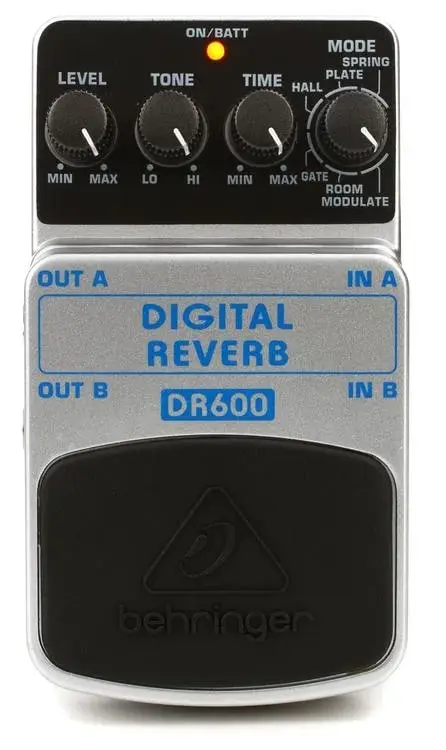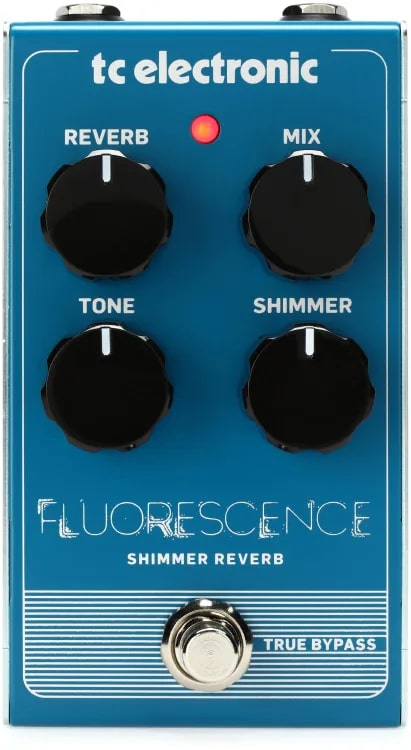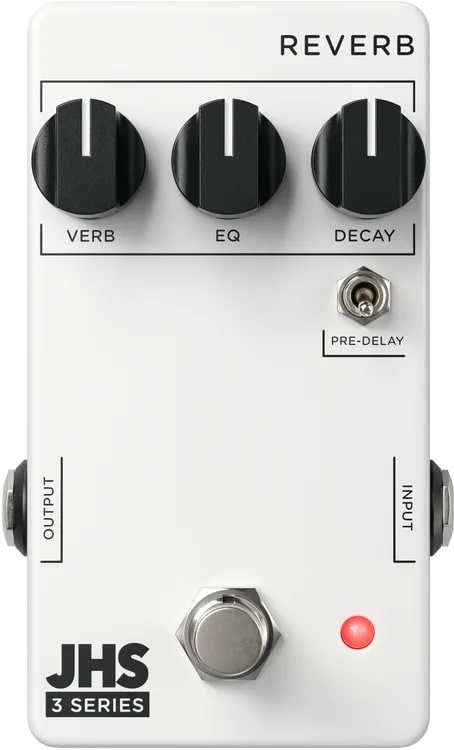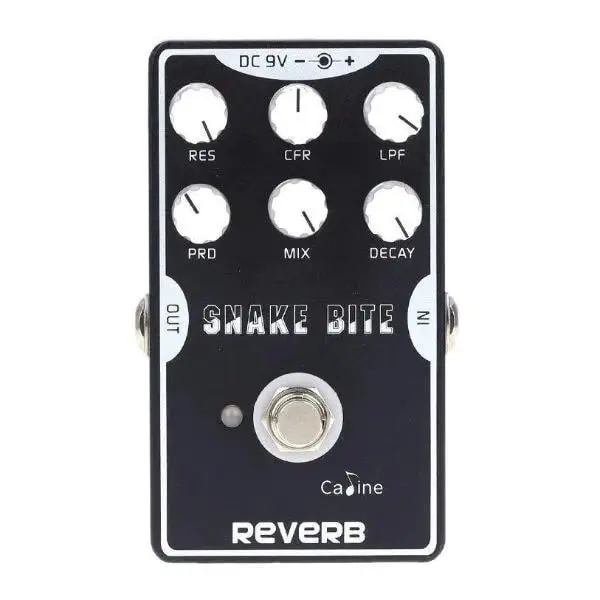When you buy through our links, we may earn an affiliate commission.
If you're a musician looking to add depth, dimension, and ambiance to your sound without breaking the bank, you're in the right place. Reverb pedals are a fantastic way to transform your tone, creating lush and immersive sonic landscapes, whether you're playing in your bedroom or on stage.
In this article, we'll guide you through some of the best budget reverb pedals available. We'll explore a range of options, from compact and affordable choices to versatile multi-effects units that offer a multitude of reverb sounds.
We are coming the best budget reverb pedals here. If you have a higher budget or check out this article on the best reverb pedals.
Our top pick is the Behringer DR600 Digital Reverb because of its fantastic reverb tones, user-friendly interface, and excellent value.
But that's not all—we've got picks for a variety of needs, so check out our list and see if you find your next reverb pedal here. We've also included a handy buyer's guide in case you need a hand knowing what to look for.
Now, let's dive in.
Quick Summary of the Best Budget Reverb Pedals
- Behringer DR600 Digital Reverb (Best Overall Budget Reverb Pedal)
- TC Electronic Fluorescence Shimmer Reverb (Premium Choice)
- JHS 3 Series Reverb (Best Budget Reverb Pedal Under $100)
- Donner Verb Square (Best Space-Saver)
- Caline Snake Bite (Most Versatile Budget Reverb Pedal)
Best Budget Reverb Pedals
1. Best Overall Budget Reverb Pedal – Behringer DR600 Digital Reverb

SPECS
- Dimensions: 2.125" x 2.75" x 4.8"
- Weight: 11.68 oz
- Power Source: 1 x 9V battery or DC adapter
- Controls: Reverb Level, Tone, Time, Mode
Behringer is a brand that's renowned for making durable and reliable pedals, and the DR600 is no exception, despite its low price. This affordable pedal offers high-quality sounds without breaking the bank, making it an excellent choice for beginners and musicians on a budget.
The DR600 offers six different reverb modes that allow you to experiment with varied reverb types. These modes include Plate, Hall, Gate, Room, Modulate, and Spring reverbs.
This Behringer pedal also comes with user-friendly control knobs that allow you to adjust parameters like decay time, tone, and level. While not as extensive as some pricier pedals, these knobs provide enough control to shape your reverb sound to your liking.
The DR600 also features stereo output options—an excellent choice if you're running your signal through multiple amps or a stereo setup, bringing the spatial feel of your reverb to another level.
This pedal also has true bypass switching, which ensures that the pedal does not affect your guitar's tone when it's turned off, maintaining the integrity of your original signal.
Overall, the DR600 is one of the best reverb pedals you can buy at such a low price point.
2. Premium Choice – TC Electronic Fluorescence Shimmer Reverb

SPECS
- Dimensions: 2.3" x 2.9" x 5.2"
- Weight: 17.6 oz
- Power Source: 9V DC power supply (sold separately)
- Controls: Reverb, Mix, Tone, Shimmer
The TC Electronic Fluorescence Shimmer Reverb is a great pedal with a unique sound. It's known for its ability to create lush, ethereal, beautiful reverb sounds with a stunning shimmer. This shimmer mode adds octave-up harmonics to the reverb tail, creating an otherworldly and ambient texture.
The layout of the Fluorescence Shimmer Reverb is quite straightforward, with only 4 controls to master. The Reverb knob adjusts the amount of tail on your dry signal for short or long resonances.
The Mix knob lets you adjust the balance between the reverb tail and your guitar sound, while the Tone knob sets the amount of sparkle that’s added to the reverb. All this is added to classic reverbs that already have a great sound.
Lastly, the Shimmer knob rolls in the perfect amount of sparkling, angelic octave tones to round out its thick and ethereal ambiance.
Its pedalboard-friendly design allows it to fit neatly onto your pedalboard alongside other effects. Despite its size though, all TC Electronic pedals are known for their durable metal enclosures, designed to withstand regular use and gigging.
3. Best Budget Reverb Pedal Under $100 – JHS 3 Series Reverb

SPECS
- Dimensions: 1.22" x 2.38" x 4.42"
- Weight: 7.4 oz
- Power Source: 9V DC power supply
- Controls: Verb, EQ, Decay, Pre-Decay
The JHS 3 Series Reverb Pedal is part of the 3 Series lineup by JHS Pedals, designed to give you affordability and simplicity without compromising quality.
The 3 Series Reverb is a very straightforward pedal featuring just three knobs (Verb, EQ, and Decay) and a toggle switch (Pre-Delay). These controls are very intuitive and allow you to shape your reverb sound quickly and effectively.
This pedal is also incredibly versatile, including multiple reverb modes such as Hall, Plate, and Spring, among others. The EQ lets you perfectly adjust for a bright or dark texture to the reverb's overall tone, while the Pre-Delay gives you a short delay before the reverb begins.
The JHS 3 Series Reverb is built in a compact and pedalboard-friendly format, making it easy to fit onto your pedalboard and conserve space.
Don’t let its size and affordability fool you though! JHS is known for making pedals that are hardy and designed to withstand the rigors of live performance and regular use, making the 3 Series Reverb one of the best reverb pedals on the market right now.
4. Best Space-Saver – Donner Verb Square

SPECS
- Dimensions: 2.4” x 2.4” x 3.9”
- Weight: 11 oz
- Power Source: 9V DC power supply (not included)
- Controls: Level, Decay, Tone, Reverb Type Rotary Switch
Donner pedals have been making a name for themselves among guitar players as mini stompboxes that sound great and are incredibly affordable.
The Verb Square is yet another user-friendly reverb pedal with control knobs that are easy to understand and use. It comes with three knobs for adjusting the level, tone, and decay of your reverb, as well as a 7-way rotary switch to select one of seven reverb types.
Speaking of which, the seven classic reverb sounds this versatile reverb pedal offers are Plate, Studio, Modulation, Room, Hall, Church, and Spring reverb.
One of the best features of the Verb Square is its compact size. If you have a busy pedalboard or you have to move your rig around a lot, this mini pedal will fit right in.
While small and budget-friendly, the Verb Square is highly durable. It also comes with a bright LED indicator to easily identify when the effect is active. This can be particularly useful in dimly lit or stage settings.
5. Most Versatile Budget Reverb Pedal – Caline Snake Bite

SPECS
- Dimensions: 5.31” x 2.36” x 3.54”
- Weight: 9.4 oz
- Power Source: 9V
- Controls: Res, CFR, LPF, PRD, Mix, Decay
The Caline Snake Bite is a really special pedal. While it doesn’t have a select reverb mode, it nonetheless offers plenty of options to adjust the reverb tone.
It has six knobs to adjust various settings: Res (or Resonance) simulates the resonant acoustics of different environments; CFR adjusts the Center Frequency; LPF (or Low Pass Filter) adjusts the radio-frequency component of the reverb; PRD (or pre-delay knob) adjusts the time between the dry signal and the onset of the reverb; Mix for choosing between wet and dry, signals; and Decay to adjust the delay time.
This makes for an incredibly versatile pedal with a myriad of different sounds that allow you to fine-tune your reverb to your heart’s content. Experimentation is the name of the game with the Caline Snake Bite.
Another great aspect of the Snake Bite is its robust build quality with metal enclosures designed to withstand regular use, aside from being compact and pedalboard-friendly.
Best Budget Reverb Pedals Buyer's Guide
Still not sure which pedal is the best for you? Our buyer's guide is here to help you take stock of some important factors to consider when shopping for affordable reverb pedals.
Digital Reverb Pedals
Digital and analog reverb pedals are two distinct types of pedals that achieve the reverb effect in different ways.
Digital reverb pedals use digital signal processing (DSP) technology to generate reverb effects. They employ algorithms to simulate the sound of reverb by manipulating the digital representation of the audio signal.
This makes them highly versatile since they can emulate a wide range of reverb types, from classic spring and plate reverbs to hall, room, and even experimental effects like shimmer and reverse reverb. They often offer more options and presets for different reverb sounds.
Digital pedals typically come with a variety of tone controls that allow precise adjustment of reverb parameters such as decay time, mix, tone, modulation, and more. This level of control can be very useful for tailoring the effect to your exact preferences.
They also offer consistent performance and sound quality, regardless of environmental conditions. They are not affected by temperature changes or wear and tear in the same way analog components might be.
Digital pedals are generally reliable and require less maintenance than analog pedals. They often come with features like preset storage, making them user-friendly for live performances.
Digital reverb pedals tend to be more affordable than high-quality analog reverb units because they use DSP technology, which is cost-effective to produce.
Analog Reverb Pedals
On the other hand, analog reverb pedals use analog electronic components, such as springs or physical plates, to create the reverb effect. These components introduce subtle imperfections and coloration to the effect, which can result in warm and organic-sounding reverb.
Analog reverb pedals are known for their unique character and the "vintage" sound they produce. They often have a distinct warmth and natural decay that many musicians find appealing.
They also tend to have simpler control interfaces with fewer knobs and parameters to adjust. While this can limit the extent to which you can adjust the reverb, it can also make it more intuitive for some players.
Analog reverb pedals with physical components, like spring or plate reverbs, may require occasional maintenance and can be more susceptible to wear and tear over time. They can also be influenced by environmental factors like temperature and humidity, which can affect their performance and sound.
High-quality analog reverb pedals, especially those with spring or plate reverb tanks, can be relatively expensive due to the specialized components and craftsmanship involved in their production.
Reverb Types
Reverb pedals can emulate various types of reverbs, each with its own character. For example, Spring reverb simulates the sound of a spring tank, Hall reverb replicates the acoustics of a large concert hall, Plate reverb emulates a metal plate, Room reverb simulates a smaller space, among others.
Some advanced reverb pedals even offer experimental or creative reverb effects like shimmer or reverse reverb.
Consider your musical genre and playing style to determine which types of reverb are most relevant to your sound.
True Bypass
True bypass is another important feature to look for since it maintains the integrity of your guitar's tone when the pedal is switched off. It ensures that your signal passes through the pedal without any coloration or degradation, making it a must for purists who want a clean tone.
Size
A guitar player's pedalboard can get busy, so consider the size of your new pedal. Smaller pedals are great for conserving space, making them ideal for crowded pedalboards. However, larger pedals often provide more control options and can be easier to adjust on stage.
Build Quality
A pedal's build quality affects its durability. Sturdy metal enclosures are more reliable and can withstand the rigors of live performances or frequent use. Be cautious of plastic pedals, which may not hold up as well over time.
Power Supply
Some pedals rely on a 9V battery, while others require a 9V DC power supply. Battery-powered pedals are portable but can be costly to maintain if they need frequent battery changes. DC-powered pedals are generally more convenient for everyday use.
Additional Features
If you're looking to experiment with your reverb sound, consider pedals that offer additional effects like modulation or shimmer. Modulation can add movement and depth to your reverb, while shimmer creates ethereal, octave-up textures.
Depending on your needs, a reverb stompbox with an expression pedal input can offer several advantages. From sweeping effects to real-time control, an expression pedal will make experimenting with guitar effects a breeze.
Frequently Asked Questions (FAQs)
What is a reverb pedal?
A reverb pedal is an effects pedal that is used to add a sense of space and ambiance to an audio signal, typically that of a musical instrument, most commonly a guitar.
It simulates the reverberation or echo that occurs when sound waves bounce off surfaces in a physical environment, such as a room, a hall, or a canyon. Reverb pedals are widely used in music production and live performances to create depth, dimension, and atmosphere.
How does a reverb pedal work?
The quick answer is that a reverb pedal works by simulating the natural reverberation that occurs when sound waves reflect off surfaces in a physical environment. It creates the illusion of space and depth in audio signals.
Here's the longer answer.
- Input Signal: The reverb pedal takes an audio signal as its input, typically from a musical instrument, such as an electric guitar, keyboard, or microphone.
- Signal Processing: Inside the reverb pedal, the input signal undergoes signal processing. There are two main approaches to generating reverb effects: digital and analog, which we covered in the section above.
- Reverberation Simulation: Regardless of whether the pedal is digital or analog, it generates a series of delayed and attenuated copies of the input signal. These copies simulate how sound waves interact with surfaces in a physical environment. Each copy represents a reflection off of a different surface, and these reflections combine to create the effect.
- Control Knobs: Reverb pedals often come with control knobs that allow you to adjust various parameters.
- Output Signal: After processing, the reverb pedal outputs the processed audio signal, which includes the added reverb effect. This signal can be mixed with the original dry signal and sent to an amplifier or other audio equipment.
Where does a reverb go in the pedal chain?
We should first point out that there are no strict rules for pedal placement, and personal preference plays a huge role. The best way to go about it is to experiment and listen to how the reverb interacts with your other effects to get the sound you want.
Having said that, there are some common placements for a reverb pedal that you can start with.
Early in the Chain (Before Gain Effects)
Placing the reverb pedal early in the chain, before gain-based effects like overdrive, distortion, or fuzz, can create a sense of space and depth in your dry guitar signal before it gets distorted.
This placement can be useful for adding ambiance to your clean tones or lightly overdriven sounds. It's a common choice for those who want a reverb that responds to dynamics and picking articulation.
Pedal Order: Guitar > Reverb > Overdrive/Distortion/Fuzz > Modulation > Delay > Time-based Effects > Amplifier
In the Effects Loop (After Gain Effects)
Many amps have an effects loop that lets you place effects after the preamp stage (where gain is added) and before the power amp stage.
Placing your reverb pedal in the effects loop can provide a different sound because it adds reverb to the amplified signal. This can create a more natural and spacious sound as the reverb interacts with the already distorted or overdriven guitar signal.
Pedal Order: Guitar > Overdrive/Distortion/Fuzz > Modulation > Delay > Reverb > Amplifier
Last in the Chain (After All Effects)
This is a common placement for a reverb pedal and can create a lush and atmospheric sound. This setup allows the reverb to affect all your other effects, including modulation and delay, resulting in a more blended and ambient sound. It's especially useful if you want to add a sense of space to your entire signal.
Pedal Order: Guitar > Overdrive/Distortion/Fuzz > Modulation > Delay > Time-based Effects > Reverb > Amplifier
As Needed for Specific Sounds
Depending on your music and preferences, you can experiment with placing the reverb pedal wherever it works best for specific songs or sounds. Some players even use multiple reverb pedals at different points in their signal chain for added versatility.
Conclusion
While these great pedals may not necessarily have all the bells and whistles of high-end pedals, these budget-friendly options offer a solid performance for excellent value.
Our top pick for the best budget reverb pedals was the Behringer DR600 Digital Reverb because of its fantastic reverb tones, straightforward interface, and great durability.
As always, consider your specific needs—such as reverb types, control options, and build quality—to find the best reverb pedal for you.
Explore our selection of the best sustain pedals for keyboards and elevate your playing experience.
Discover our top choices for the best guitar pedal switchers and gain control over your effects. Explore our list and choose the right type of pedal switcher for you.
